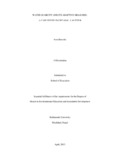
Please use this identifier to cite or link to this item:
https://hdl.handle.net/20.500.14301/237| Title: | WATER SCARCITY AND ITS ADAPTIVE MEASURES: A CASE STUDY IN CHYASAL, LALITPUR |
| Authors: | Shrestha, Soni |
| Citation: | Shrestha,S.(2013).Water scarcity and its adaptive measures: A case study in Chyasal, Lalitpur. |
| Issue Date: | Apr-2013 |
| School: | SOED |
| Department: | DODE |
| Level: | Masters |
| Program: | KUMSD |
| Abstract: | Drinking water is one of the most important components for human survival. Development should address the availability of drinking water facilities because it is still a major problem across many human settlements. Water scarcity has become a lifestyle for the resident of Kathmandu valley. With the increase in the population of the city, water has been a common problem in most of areas. They lack optimum access to drinking water supply. The population keeps on increasing but the water supply provision still remains persistent. The oldest water source – stone spouts have run dry, the piped system is no longer capable to deal with the population growth, and thus bottled water has become the preferred choice as the source of drinking water. Kathmandu, the capital city of Nepal, is facing problems associated with the delivery of drinking water. This study aimed to explore the adaptation of the people to the problem of water scarcity in Chyasal, Lalitpur; the reason behind the existing scarcity and the existing mitigation measures adapted by the local people. Four research questions were (1) How have Chyasal people perceived the problem of water scarcity? (2) What has been the past trend and present scenario ii regarding water availability? (3) What are the major reasons behind existing water scarcity? And (4) what practices are the people adapting to minimize the effects of water scarcity on their livelihood? To identify the situation on scarcity of water and its adaptive measures, the research was designed from interpretive paradigm using qualitative study. Twenty one people were purposively chosen to represent the population. The study found that water availability has diminished in the study area leading some of the people to change their profession. This showed a strong perception of the people towards the water scarcity. The study has revealed that dense population, construction of new buildings, and low percolation (infiltration) were some of the reasons behind water scarcity. People were found to adjust themselves differently such as buying water, rain water harvesting, or collecting water through local wells/taps in the community. In addition, the irregular and uneven supply of water by the Kathmandu Upatyaka Khanepani Limited (KUKL) was also one of the reasons to aggravate the water scarcity. My study draws the attention of the concerned authority (KUKL) to take care of the problem and suggests that the Community based water supply system should be further encouraged. |
| URI: | https://hdl.handle.net/20.500.14301/237 |
| Appears in Collections: | Research Project |
Files in This Item:
| File | Description | Size | Format | |
|---|---|---|---|---|
| soni,final thesis1.pdf | 1.01 MB | Adobe PDF |  View/Open |
Items in DSpace are protected by copyright, with all rights reserved, unless otherwise indicated.